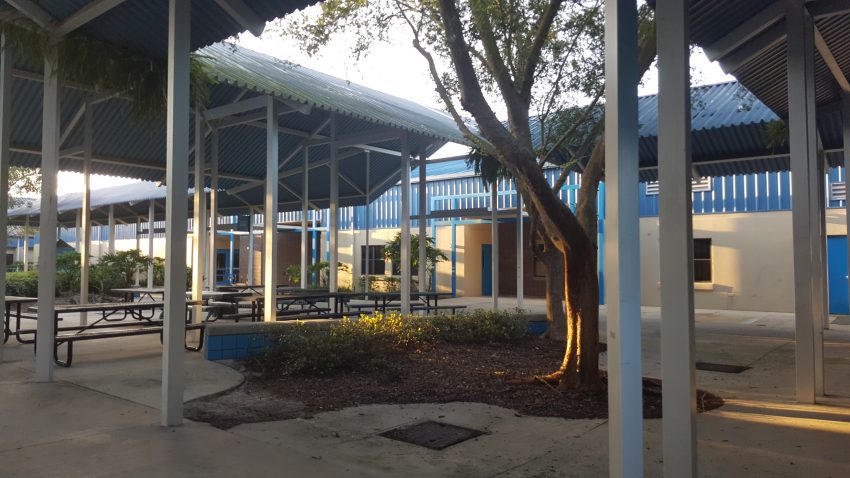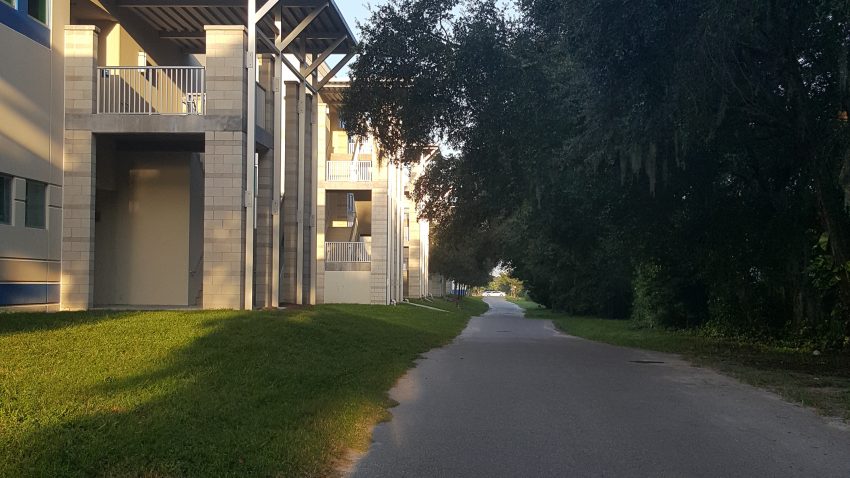By: Cassidy Johnson
Many facets of Apopka High School are still the same as last year. The stairs are a gridlock, not helped by freshman who don’t where to go. There are more students than there were last year, and campus life is already underway from the first day of school. The student body is enthused by pep rallies in the courtyard every Friday, and no one can wait for Homecoming.
One thing that is glaringly different about Apopka High this year is its expanded campus. Students are taking classes all the way from the 1600 building to the newly dubbed “North Campus.” The North Campus was once the Ninth Grade Center, but for the past few years housed displaced elementary schools while their own campuses were being rebuilt. This year, however, the North Campus is home to the high school’s Medical Magnet program where students, freshman to senior, dwell for 46 minutes at a time.
Mr. Arnold credits the use of the North Campus this year to the growing population of Apopka. The school was projected to have 200 more students, “so with that we needed more classrooms,” explained the principal. The new addition to the campus houses the biomedical classes, an ESOL reading teacher, and Latin. These classes were chosen for several reasons, including the scientific equipment already there, the pairing of Latin with the Medical Magnet, and the limited number of students taking the classes. Mr. Arnold has every intention of using the North Campus from now on. Displaced elementary schools will no longer be able to use the facilities.
Some students did know that they would have to make the trek back and forth between the North and Main campuses (or elsewhere), but many were unaware of the distance their classes would take them. Junior Georgea Serwe was unaware that her Medical Interventions class would take her so far. It takes the Yearbook editor about 8 minutes to get to the supplemental buildings, and she is about 3 minutes late on her return to the main campus. If she had known last year that she would have to travel farther than the SGA building, Georgea probably would not have taken the class. She spoke for many students when she said the walk makes her feel “tired and sweaty” every day.
The teachers, however, were not in the dark about the change in locale. The Medical Magnet teachers knew they would be teaching at the North Campus since the start of the fourth nine weeks last school year. AP Biology and Medical Interventions teacher Mrs. Jandy explained the circumstances of the move. “We had the option to decide as a group of teachers from the Medical Magnet,” she revealed. It’s a decision Ms. Gruman, Biomedical Innovations and AP Biology teacher, does not regret. Compared to the main campus, the North “is so quiet and the kids are so respectful over here. It’s really nice,” said Gruman.
It’s not only magnet students affected by this change. Many educators in the North Campus teach additional science courses. Twin seniors, Brittany and Bianca Beckwith, take AP Biology with Mrs. Jandy at the North Campus. Their next class is band, so if they rush across two campuses they can make in 9 minutes. Just enough time to set up their instruments after everyone else has warmed up. When asked if they knew AP Bio would be in the North Campus, the Beckwiths adamantly said, “No!” in twin fashion.
Despite it being an odyssey moving from one campus to another, students are not officially allotted any extra time to get from place to place. During the second week of school kids were administered stickers to put on their Student IDs in order to designate them as North Campus students to administrators and teachers.
All over the high school, administrators and teachers are instructing students to “walk with a purpose,” meaning we should be invigorated as we move, intent on getting to class on time. Walking with a purpose is quite possible. However, getting to class on time is no easy feat. Students are prohibited from exiting hallways out the back doors and using the fire lane to reach the North Campus faster. Orange County Public Schools has determined that “blocking” the fire lane with human bodies is a safety hazard. To enforce this mandate some teachers post themselves at the end of halls preventing anyone from exiting out the back. Nevertheless, using the shortcut is inherently faster.
I timed myself walking to and from the North Campus. Leaving from the farthest third floor 500 stairwell, I went out the back, walking the fire lane. Be mindful this was in the middle of a period–there were no other students to slow me down. The only obstacle I faced was moving to the grass to avoid a service truck. Starting the clock as soon as I stepped out the Emergency Exit doors, it took me 4 minutes and 57 seconds to reach the first hallway of the North Campus, and another 22 seconds to reach Ms. Gruman’s room inside. This brought the total time it took me to get to class–with no human traffic or even a backpack to slow me down–to 5 minutes and 20 seconds. Students have 6 minutes before the late bell rings. Ponder this: If it took me, a healthy and able-bodied teenager, that long to make the journey, how long does it take a crowd, dealing with other persons and school materials after packing up your things from “bell to bell instruction?”
Mrs. Jandy gives her students a bit of leg room. “From what I know, when this was the Ninth Grade Center they gave the students 8 minutes to get to class. So I gave my students a buffer of 2 minutes, and after then I start marking tardies.” If a student continually shows up to class after that buffer period Mrs. Jandy follows the school’s tardy policy .
Right next door, Ms. Gruman chooses to reprimand her students in an alternative fashion. Instead of keeping watch of a few extra minutes like Jandy, Gruman simply chooses to not devote any class time to catching up the students who milk her generosity. “It’s just like when you only have 46 minutes, am I wanting to spend 5 minutes of that on people that are late, because they’re already confused? They’re already hurting themselves. I can only do so much,” explained Ms. Gruman. In a way she is allowing the students to punish themselves.
Nonetheless, it is third week of school, and classrooms are not going to magically change location. Students and teachers will have to get used to it for the next 33 weeks. “It’s just a transition period,” said Mrs. Jandy, before finding a silver lining: “It’s probably good for [students] since they’re sitting in their chairs all day anyway.”


